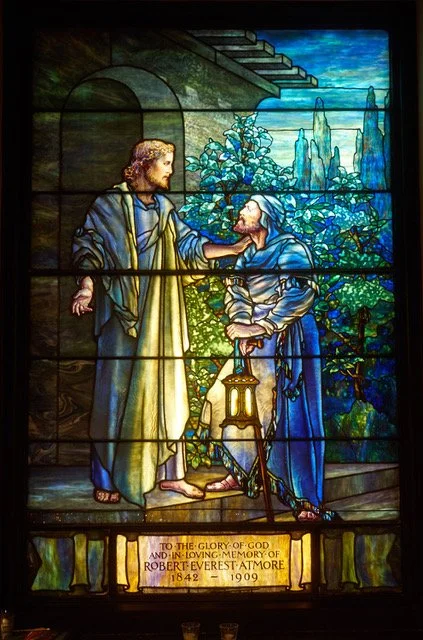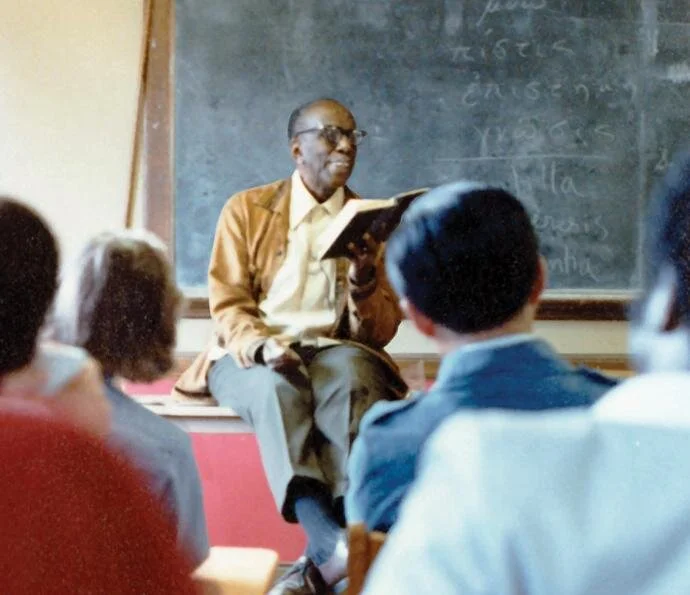Friday Reflection: To be a Priest–Revisiting Alexander Crummell (1819-1898), Part I
We are living in this country, a part of its population, and yet in divers respects, we are as foreign to its inhabitants as though we were living in the Sandwich Islands. It is this our actual separation from the real life of the nation, which constitutes “a nation within a nation”: thrown very considerably upon ourselves for many of the largest interests of life, and for nearly all our social and religious advantages.
–Alexander Crummell, “The Social Principle Among a People,” from Destiny and Race, p. 32
View Alexander Crummell’s biography
(Image source: House Divided: Civil War Research Engine, Dickinson College)
I. Regular readers of our “Friday Reflections,” will remember that we met Alexander Crummell in the August 7 reflection, “Of William Edward Burghardt DuBois (1868-1963) and Alexander Crummell (1819-1898).” The primary character in that essay was W.E.B. Du Bois but Alexander Crummell was a very significant secondary character and one who deserved a much fuller consideration. That the church celebrates Alexander Crummell on September 10 offers a perfect opportunity to consider Crummell as the unique individual he was: as moral philosopher, scholar, academic, teacher, writer missionary, abolitionist, pan-Africanist, important African American historical figure, and as an Episcopal priest.
II. Crummell is not to be found in the recent Black History Matters: Civil Rights Movement Heroes (2020). Among the people celebrated in this book are Martin Luther King, Jr., Malcolm X, Rosa Parks, Ida B. Wells, Frederick Douglass, Harriet Tubman, Nannie Helen Burroughs, W.E.B Du Bois, Thurgood Marshall and Pauli Murray. There are, of course, scores of distinguished Black Americans who could have been included in such a volume. The judgement of whom to include, in this case, belongs to the author, L.A. Amber.
III. I suspect Alexander Crummell was not included because he was who he was: a mostly in-and-out-of-the-limelight and brilliant Black American who was an outlier, as much as he was a person with an extraordinary combination of gifts and talents, so unusual as to be overwhelming. And, he was a priest of the Episcopal church, whose calling and way is not easily understood. In preparing to write this reflection, I realized more and more how “large” a character Alexander Crummell was. So large, in fact, that to do justice to Crummell and his story, this reflection will come in two parts, with Part Two coming next week (September 18).
IV. Readers will remember the compelling description of Crummell that W.E.B. Du Bois offered in his The Souls of Black Folk, that Crummell “had bent to all the gibes and prejudices, to all the hatred and discrimination, with all the rare courtesy which is the armor of pure souls”… a man who knew “the temptations of hate, despair and doubt.” (SOBF, p. 258, 247). And read again the passage from Crummell that opens this essay and you will understand the breadth of prejudice that came with being a Black person in America in the 19th century. Imagine being a foreigner in one’s own country and being separated from the “real life of the nation.” And then imagine if you were a serious—and published-- moral philosopher whose skin color forced you to reconcile what you knew as a philosopher with the immorality of racism. Stephen Thompson, writing in the Stanford Encyclopedia of Philosophy, contends that Crummell was perhaps “the most prominent rationalist of the black American enlightenment thinkers in the nineteenth century.” (Thompson, S., “Alexander Crummell,” Stanford Encyclopedia of Philosophy). In this superb 16-page essay, including the biographical section, there is an important recognition of Crummell’s becoming a priest: that he successfully trained for the priesthood, becoming an Episcopal priest in 1844 “despite race-based resistance.” (Thompson, ibid)
V. It is as a priest that Crummell became a “moral exemplar” for W.E.B. Du Bois and for so many other Christians, Blacks and Whites alike, in latter part the 19th-Century. Everything he did as an advocate for the abolition of slavery and the removal of discriminatory restrictions for black Americans; everything he did fighting for the right to vote and for the creation of new African American schools; everything he wrote and said about the evils of racism and the need for black leadership; all of his academic work was, I believe, grounded in Crummell’s calling as a priest; in the Gospel and the commitment to its principles and commandments. But Crummell’s path to the Episcopal priesthood was made enormously difficult by the very people whose responsibility it was to watch over, support, and care for the call to the priesthood, and for those who were called: the Episcopal Bishops. In one sense, then, the story of Alexander Crummell is the story of his priesthood and how he reached ordination and how he lived everything he did in the context of his life as a priest. And interestingly enough, no one seemed to know this better than W.E.B. Du Bois.
VI. Alexander Crummell was born in 1819 and raised in New York City, in an abolitionist family. Both his parents were free and the life of the family was an abolitionist life, professionally and personally. The Crummell parents, for example, published the first African-American newspaper, Freedom’s Journal from their house, co-founded by an Episcopal priest, Peter Williams, the second African American Episcopal priest in the United States who would become so important in helping Crummell shape his own calling to the priesthood. Crummell was home schooled until the age of thirteen when he entered the African Free School, a Quaker school. Among his classmates was Henry Highland Garnet who was to become a famous abolitionist. After the African Free School, Crummell and Garnet entered the Canal Street High School, a school for Black youth, established by Peter Williams. Crummell was formed in his beliefs, values, and actions by his parents, his schooling, and by the abolitionist community.
VII. In 1835, Crummell and some of his Canal Street classmates entered Noyes Academy, a progressive school for all races and sexes established by New Hampshire abolitionists in Canaan, NH. The school was seen as a great opportunity for Crummell and his classmates but soon enough townspeople and farmers, in a fit of racism, attacked the school and destroyed what they called “the abolition nest.” The school did not last even a year. From the rubble of Noyes Academy, Crummell moved to the Oneida Institute near Utica, New York, at the time the leading abolitionist school in the country.
VIII. In 1836, Crummell, Garnet, and three other students from Noyes came to the Oneida Institute at a time when the institution had begun to enroll African American students and was increasingly committed to the abolition of slavery. What was also wonderful for Crummell is that the Oneida curriculum included ethics and moral philosophy, as well as Hebrew and New Testament Greek. Perhaps of greater importance is that, under the direction of Peter Williams, Crummell became more and more convinced that he was called to the Episcopal priesthood. As mentioned earlier, Williams was an Episcopal priest, and the founder and Rector of Saint Phillips, in New York City, the second black Episcopal parish in the United States. There is every indication that Peter Williams was a spiritual mentor to Crummell, as Crummell was a spiritual mentor to W.E.B. Du Bois. By the time Crummell left Oneida in 1839, and with Williams’ counsel, he had decided to apply to the General Theological Seminary in New York City (GTS) for admission.
IX. Alexander Crummell’s application for admission to General Theological Seminary was rejected because he was black; he had faced the “color line,” once again. Crummell appealed the decision to the Seminary trustees and to the Episcopal Bishop of New York, Benjamin Tredwell Onderdonk. Onderdonk upheld the decision of the seminary. Crummell’s response was that because of his audacity in appealing the admission decision, “Bishop Onderdonk sent for me and…set upon me with a violence and grossness that I [had]never encountered…” ( the Alexander Crummell papers in the Schomburg Center, New York Public Library, L.D. Reddick author, p. iii)
X. Through supportive people connected with the GTS trustees, arrangements were made for Crummell to meet with Alexander Viets Griswold, the Bishop of Massachusetts and Rhode Island who was, in contrast to Bishop Onderdonk, gracious in conversation and warm in manner. Crummell had this to say about his encounter with Bishop Griswold: “My removal from New York to Boston seemed a transition from the darkness of midnight to the golden light of a summer morning…Just think of a simple black boy, in 1840 being received in the very Mecca of American culture, refinement, and piety, with courtesy and manly recognition, with Christian fraternalism.” (Reddick, ibid). Crummell was received into the Diocese and in early 1840, he began his path toward ordination in a process called “Reading for Holy Orders.” Through individual study and other forms of preparation and discernment, as well as parish service, Crummell was accepted as a candidate for ordination. He was ordained as a Deacon in 1842 and as a priest in 1844, when he was twenty-five years old.
XI. In his essay on Alexander Crummell, W.E.B Du Bois wrote that Crummell discovered that “there was little scope for black priests.” (SOBF, p. 139). I mentioned earlier that Crummell was a missionary priest so he was able to find a small black mission in Philadelphia to serve. Following the Diocesan protocol, Crummell petitioned the Bishop of Pennsylvania, Henry Onderdonk whose brother was the Bishop of New York, Benjamin Onderdonk, to be received into the Diocese of Pennsylvania and establish another official Diocesan parish to serve Philadelphia’s African American Community. Bishop Onderdonk reportedly rendered his decision this way: “I will receive you into this diocese on one condition: No negro priest can sit in my church convention and no negro church must ask for representation there.” Du Bois writes that Crummell responded, “I will never enter your diocese on such terms.” (SOBF, ibid). We end the first part of the narrative on Crummell here, reminding our readers that next Friday, September 18, we will offer the second part of Crummell’s story. There is so much more to learn about Crummell’s life and his endurance and fidelity to his priesthood, his race, and his family.
XII. The second assigned reading for the commemoration of Alexander Crummell is from the Letter of James, 1:2-5. My brothers and sisters, whenever you face trials of any kind, consider it nothing but joy, because you know that the testing of your faith produces endurance; and let endurance have its full effect, so that you may be mature and complete, lacking in nothing. If any of you is lacking in wisdom, ask God, who gives to all generously and ungrudgingly, and it will be given to you.
In this coming week, let’s think about why Alexander Crummell is such a compelling figure and how remained strong in the face of his many trials of his life. James helps us understand that facing our own trials is the “testing of our [Christian] faith,” knowing that, in our endurance and fidelity, God will minister to us “generously and ungrudgingly.” Is this not what Crummell models for us? This, and his ability to forgive but not forget?
Amen
—Father Peter Kountz










